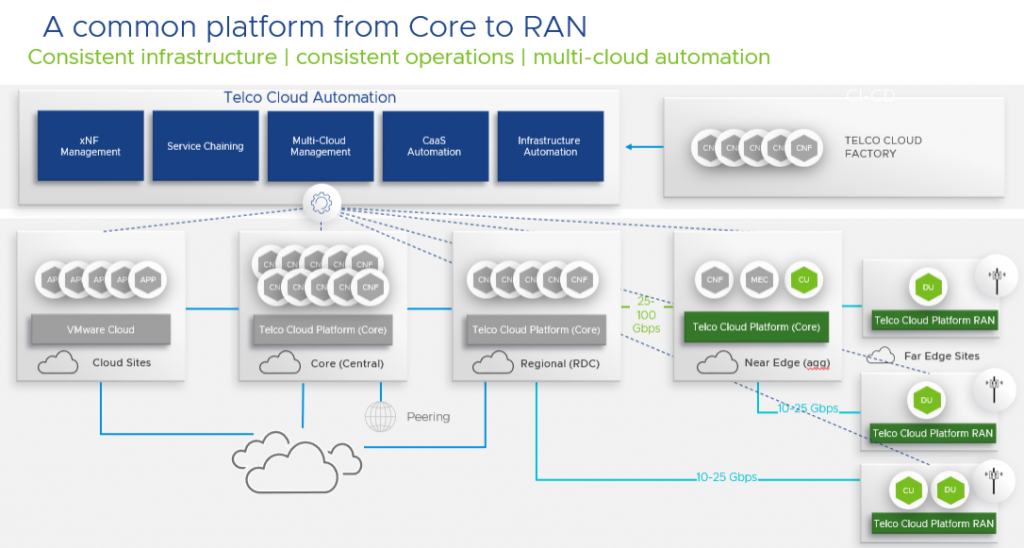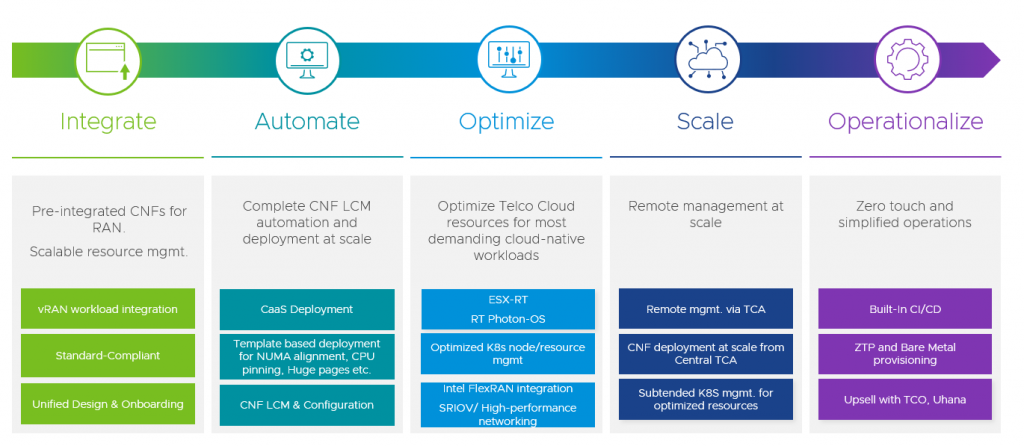Running a large-scale network operation has always been expensive and 5G hasn’t changed that equation—at least not yet. 5G has already begun unlocking more efficient operating models and lucrative new services, but the journey is still underway, so most communications service providers (CSPs) are still en route to realizing major value from their 5G investments. One of the largest opportunities to save OpEx and increase operational agility for 5G is in the radio access network (RAN).
RAN currently makes up more than 50% of the CSP’s costs. But operators see an opportunity to drive down that figure and accelerate time-to-value of their network investments by leveraging efficiencies of cloud native deployments. With containerized 5G network components leveraging the Open RAN architecture, CSPs can now disaggregate previously monolithic RAN components. They can optimize their operations by running some of these RAN functions in cloud data centers rather than at the base stations and benefit from cloud scalability, automation efficiency, and centralized control.
So, when can CSPs start reaping the benefits of moving RAN workloads to the cloud? The answer is right now. VMware and our biggest CSP customers have spent the last few years working together on their RAN transformation journeys. We’ve rolled up our sleeves with some of the industry’s leading CSPs from around the world to automate and simplify multi-cloud networks.
Through these early successes, we’ve learned a lot about the role cloud plays in today’s RAN deployments. Let’s dive into how this new landscape looks and where VMware fits within tomorrow’s cloud optimized RAN.
What is “Cloud Optimized RAN”?
With the massive growth of hyperscale cloud providers like AWS, Azure, and Google in every industry, it has become all too easy to equate “cloud” with “public cloud.” And if that is what you are thinking when you read “cloud optimized RAN,” much of that vision is still yet to come.
Even though we can disaggregate and “cloudify” more parts of the network than ever, RAN workloads still have inherent limitations on where they can be deployed. As of today, the extreme performance and low-latency requirements of RAN workloads mean they still have to run close to cell sites, either directly at base stations or at nearby far-edge data centers. The need is for flexible virtualized distributed infrastructure that can run on either CSP or hyperscaler owned infrastructure deployed within 10~15km from the cell site. There is no scenario where operators can send the complete RAN workloads for processing in public cloud—at least not yet– as the public cloud SLAs are not stringent enough to honor the requirements of RAN.
If we use the broader definition of cloud, however—RAN workloads running on off-the-shelf server environments rather than specialized hardware—that’s happening right now. VMware is implementing this today with customers like DISH, running RAN workloads in Open RAN cloud environments at or close to cell sites. These deployments decompose previously monolithic RAN technologies into distributed and centralized units (DU and CU), either with both running at a local data center (LDC) or with CU at the LDC and DU at the cell site or far-edge data center.
Such new models bring cloud scalability, flexibility, and resource-pooling to today’s RAN. They also offer a preview of the future when CSPs will reduce RAN costs further by aggregating workloads in more centralized cloud data centers, even as they deliver 5G services with high throughput and very low latencies.
Driving Value in Cloud Optimized RAN Deployments
Given the growing adoption of cloud in radio networks, let’s clarify the role a company like VMware will continue to play here. As CSPs work more with the hyperscalers to cloudify the RAN, the most successful will do it in a way that helps them retain control of innovation and customer relationships, while diversifying capabilities with multiple public cloud resources. VMware provides that “way.” Because, as leading operators confirm, the combination of VMware and cloud brings huge value to the deployment and operation of telco networks, such as:
- Automation: VMware already drives down CSP operating costs and complexity with our Telco Cloud Platform, and we will continue to in the RAN. By automating many aspects of deployment, scaling, CI/CD pipeline integration, and ongoing lifecycle management, we make it much simpler and less expensive for operators to benefit from cloud-native innovation. Given the complexity of 5G radio deployments, these capabilities become even more critical, enabling operators to roll out new 5G services more quickly, at a lower cost.

- Multivendor simplicity: Open RAN architectures will allow CSPs to tap innovations from any Open RAN standards-aligned vendor. Yet, moving from a monolithic, vertically integrated RAN to a multivendor environment does add complexity. VMware makes this evolution easier by taking on much of the burden of integrating multivendor telco environments. CSPs will be able to choose containerized RAN network functions (NFs) from an ecosystem of leading vendors, all of which are pretested and validated to run on our vendor-agnostic, intrinsically secure platform. We already do this for core network elements, where more than 200 third-party NFs are validated and ready to deploy with our Telco Cloud Platform. We’re bringing that simplicity to cloud optimized RANs—both for NFs and new RAN Intelligent Controller (RIC) applications, which VMware customers are already using to disrupt RAN economics.
- Multi-cloud flexibility: Hyperscalers have done incredible things in the markets where they operate, and we should expect them to bring exciting innovations to the RAN. Perhaps the biggest benefit of working with VMware then is our ability to preserve CSPs’ independence to work with any and all of them. As hyperscalers compete to open new possibilities for radio networks, VMware customers need not worry about getting locked into one cloud player or another. This flexibility can be particularly important in dealing with variability across a CSPs’ network footprint and the need to run RAN workloads close to cell sites. There may be markets where one public cloud provider can offer local cloud resources to meet those needs but others can’t. CSPs working with VMware can run RAN workloads in whichever cloud works best for each market, and even for each application. VMware’s multi-cloud capability creates more choice, flexibility and control for operators, it helps them take full advantage of the resource of any cloud without the risks of cloud vendor lock-in.

The VMware Multi-Cloud RAN Advantage
As the RAN continues to evolve, the benefits VMware brings to CSPs will continue to be just as important, if not even more so. After all, we will eventually surpass some of today’s limitations on latency and performance-sensitive RAN workloads. At that point, cloud will have an even greater impact on reducing RAN costs and accelerating time to value. As it does, CSPs who can draw on VMware automation, simplicity, and multi-cloud flexibility in a secure, scalable, easy-to-deploy environment will be in the best position to capitalize.
The benefits of working with VMware in the RAN – and anywhere in the network – don’t stop with technical benefits, however. Partnering with VMware allows CSPs the opportunity to work with the top pedigree in the cloud and software world in which they’re headed. Our customers learn how to expedite innovation, accelerate time to value and operate in new ways, to support their unique visions for the future. And the good news? Enabling these visions, creating more agile RAN, and enabling a robust multi-cloud network is possible, today.
It’s real and we’re doing it together.
To learn more visit our website.
Discover more from VMware Telco Cloud Blog
Subscribe to get the latest posts sent to your email.








